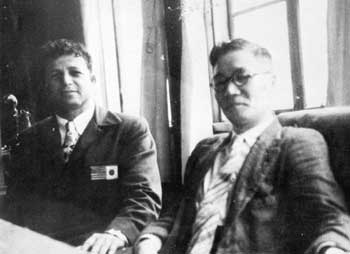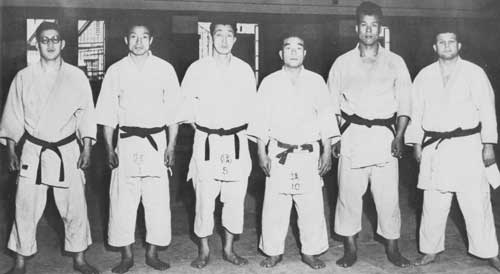(and other historical comments)A Letter from Emilio BrunoJune 20, 1972 Dear Don: Thanks for your good letter of 15th of April. Glad to know your interest in the need to documentate hand-to-hand sports. With your excellent experience and knowledge, you are in a good position to do this. Regarding my interest to assist the development of sport judo as well as the Japanese Martial Arts in the U.S. in the early days, I am forwarding the attached package of bits of material for your review and research. I am sorry to send you my personal materials involving public relations, letters, etc.; however, you may need to evaluate the authenticity of other materials. On future correspondence on the work you have in mind, I suggest you initiate contact with Donn Draeger, c/o CPO Box 270, Tokyo, Japan, as I personally feel he is the most qualified and best source to provide you much and authentic information on the Martial Arts, (world-wide) and no doubt provide accurate records on judo competitors, World Judo Tournaments. He has in his research much information from the beginning to the present on the development of Sport Judo internationally. On hand-to-hand combat, Wes Brown and Karl Kitt are also very reliable on past hand-to-hand combat history background in the U.S. With your contact sources there and other officials, you should do very well. The key individuals to initiate and administer Judo in the U.S. for the first time on a national basis were Henry Stone, Hugo Otopalik, and Donn Draeger. Mr. Doiguchi, Mitz Kimura, Mr. Yoshida, Tosh Higashi including myself from the Northern California area were technical advisors. Henry Stone being the guiding force in view of his national wrestling experience, was selected by Hugo Otopalik as Chairman of the first Judo Sub Committee under the AAU Wrestling Committee after the acceptance of judo as sport was voted upon by committee which met at San Francisco in 1950. The first weight category system in Judo was developed by the Northern California Judo Technical Committee under the guidance of Henry Stone (1948). We established four weight divisions (130, 150, 180 and Unlimited). To preserve the “little man versus the big man” theory, the Grand Championships were established where the weight system was eliminated and the skills of true judo can further exemplify the principle of “Maximum Efficiency with Minimum of Effort”, Dr. Kano’s established “All Pervading Principle of Judo.” The weight category system and the tournament rules were patterned from our Olympic Wrestling Tournament Scoring System. All this unfolded from an old copy of the first competitive judo rules and weight system developed by R. H. “Pop” Moore Sr. at the request of Dr. Jigoro Kano during the Xth Olympic Games at Los Angeles in 1932. “Pop” was Japan’s first Olympic Wrestling Team coach. Dr. Kano envisioned the need for a weight system that far back, particularly, he was impressed with the conduct of the Olympic Wrestling Competitions, (scoring, rules, and weight categories, etc.). Incidentally, Hatta and Kotani were members of Japan’s Olympic Wrestling Team at that time. After further experience was acquired in the use of the weight category system, it was revised to its present categories, (139, 154, 176, 205, and Unlimited). Geesink’s prowess was not solely responsible for weight categories coming about but no doubt he greatly amplified this need which was already begun in the early days. His consistency in defeating top Japanese judoists in competitions in Japan and the World Tournaments certainly helped and opened up further thinking of individuals who were yet reluctant to accept weight divisions. Through military services during World War II, the Korean War, knowledge of Judo and the Martial Arts highly contributed to the national development of sport judo. The most far reaching influence was through the Strategic Air Command and the Air Force due to the interest and support given by both Generals Curtis LeMay and Thomas Powers. Through instructors who were judo trained and assigned at many of the Air Force bases in the U.S., judo was further propagated in many areas of the country where judo still was unknown. Also the program of sending SAC instructors to the Kodokan Judo Institute with the annual invitation of Japan’s Martial Arts experts to the U.S. by the Air Force certainly gave impetus to our development of the Arts. Also it was through the Air Force that it was made possible to send our first AAU – Air Force Judo Team to Japan in 1955 for our first held official international competition with Japan’s judoists. (We matched our competitors according to judo rank and size during our dual meet competitions which made competition close and interesting. We were not experienced or developed sufficiently then to take on their very best and high ranking judoists.) With Collegiate Judo also flourishing from San Jose State College under Yosh Uchida, judo made great strides all in line with Henry Stone’s strong desire for the growth of judo in the U.S. The JBBF functioning under the AAU insured the future technical advancement of judo in its true light and ideals both nationally and internationally as dreamed by the founder, Dr. Kano who, in his very early days, travelled world wide many times to introduce and promote true understanding of the Art of Judo. Several times Professor Kotani accompanied Dr. Kano on his tours to give judo demonstrations and also to take on tough wrestlers or judo competitors to vindicate the effectiveness of proper judo skill. Della Maggiorre was a judo police student of mine at San Jose State College and participated on the San Jose Wrestling Team later getting a wrestling coach job at San Jose High School assisting Gene Grattan in the community of San Jose to propagate wrestling in Northern California. Sam did much in building high school wrestling in those days. Yes, I was fortunate to have been exposed to judo and be able to incorporate it with wrestling. At San Jose State, Dudley S. Degroot, Director of Physical Education and football coach, also William Wittberger, Chief of the San Jose State Police School were the first to recognize judo and emphasized its importance at San Jose State. I was fortunate to have a scholarship to San Jose State on wrestling and later have a part time job teaching judo and self defense in the Police School there between 1937-41. Also it was during this period. Henry Stone and I joined forces to build intercollegiate judo on the Pacific Coast. After leaving San Jose State in 1941 to accept a position with the California Institution for Men, Chino, California, I passed the ball to Yosh Uchida by recommending him to “Tiny” Hartranft, SJS, Director of Physical Education and Athletics. However, during World War II, judo was dropped from P.E. curriculum there. At the end of the war, I was asked to confer with Tiny to clarify the many hand-to-hand combat, self-defense, and judo type of systems which developed from the various military training programs as Tiny was interested in formulating again a sound combative sports program. Results of our discussion included to re-secure Uchida to carry on the judo program as started prior to the war. From then on the rest is known as to the magnificent and outstanding job Yosh has accomplished there over the years. I hope you will be able to make contact with many others who have also dedicated their lives toward the development of judo in the U.S. and secure all the specifics as you mentioned in your last letter. The material I am forwarding only includes my portion of the endeavor in the past with hope that it fits with all other material you may receive. By the way, I forgot to mention Charles Yerkow as one of our very early excellent judo pioneers. In fact, Charlie published the first judo book in the U.S. during World War II. I felt his book did much to throw proper light on judo as a sport and method of self defense in the U.S. as there was much skepticism on judo in those days. However, he did not receive the credit he deserved because the skills he demonstrated in his book didn’t come up to the perfection expected by old, critical “Black-Belters” of the early days. He was an early leader and made a great contribution to the over-all U.S. judo endeavor and laid his block in the judo foundation. He may be an excellent contact for more background information. If you decide to contact him, you may be able to reach him through the Flushing YMCA, Flushing, New York. The enclosed information I have on the first two World Judo Championships are not complete. You will be able to obtain this, I’m sure, from Donn Draeger or through the Foreign Section, Kodokan Judo Institute, Tokyo, Japan. Please let me know if you need any other information or contact sources which you may desire in the Martial Arts. My delay in answering your letter was unavoidable as I have been tied up with other problems demanding my personal attention. I am pleased to forward the attached material and hope it will be useful toward your building up your research on hand-to-hand combat or combative sports documentation. Sincerely,
|

 During my trip with the U.S. Wrestling to Japan in the summer of 1950, at the request of Henry, I established liaison with Mr. Kano and other judo officials of Kodokan to discuss and review our U.S. Judo development plans including discussion of their views on a weight category system. Thereafter, many other key judo leaders from different sections of the U.S. began to pull together to formulate the Amateur Judo Federation under contract to the AAU, to preserve the technical standards of Judo. Later this federation under contract to the AAU became the JBBF. Through Henry Stone’s excellent administrative ability, tactfulness with Mitz Kimura’s assistance, Henry was able to create unity among the original Judo Yudanshakais. (Nanka, Hawaii, Seattle, Hokka, (Northern Cal), Chicago, New York, etc. Along with this beginning under Yosh Uchida, San Jose State College served as a cornerstone and the early important location to hold our first major national and intersectional judo tournaments under the guidance of Henry Stone and the Northern California Technical Committee.
During my trip with the U.S. Wrestling to Japan in the summer of 1950, at the request of Henry, I established liaison with Mr. Kano and other judo officials of Kodokan to discuss and review our U.S. Judo development plans including discussion of their views on a weight category system. Thereafter, many other key judo leaders from different sections of the U.S. began to pull together to formulate the Amateur Judo Federation under contract to the AAU, to preserve the technical standards of Judo. Later this federation under contract to the AAU became the JBBF. Through Henry Stone’s excellent administrative ability, tactfulness with Mitz Kimura’s assistance, Henry was able to create unity among the original Judo Yudanshakais. (Nanka, Hawaii, Seattle, Hokka, (Northern Cal), Chicago, New York, etc. Along with this beginning under Yosh Uchida, San Jose State College served as a cornerstone and the early important location to hold our first major national and intersectional judo tournaments under the guidance of Henry Stone and the Northern California Technical Committee.